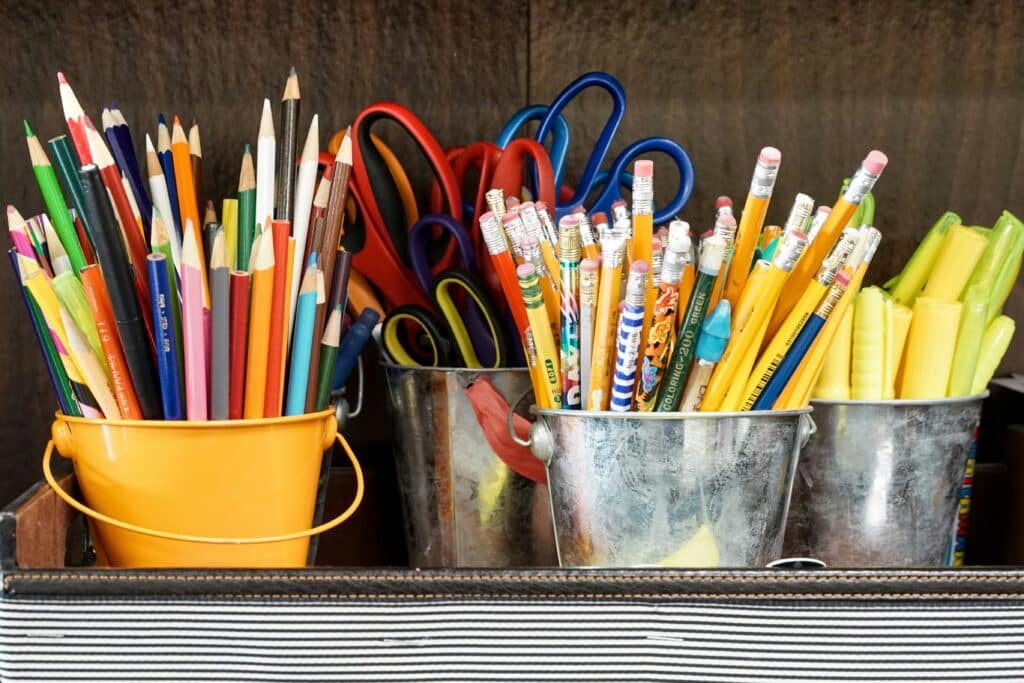Teaching our preschoolers safe scissor and tool usage is an important part of preschool. It’s all about keeping them safe while they explore and create! By teaching them how to handle scissors and tools correctly, we help prevent accidents and injuries. Plus, mastering these skills boosts their confidence and independence – they’ll be proud to tackle tasks on their own. And let’s not forget the fun part – tools like scissors, paintbrushes, and glue unleash their creativity and imagination! From preparing them for elementary school to instilling values like responsibility and respect, teaching tool safety sets them up for success while ensuring a safe and enjoyable learning environment.
Let’s start by ensuring our little ones know how to stay safe with scissors! It can feel frightening at first to give your child something sharp like scissors but teaching them how to use them appropriately keeps them safe. Here are a few things to consider.
- Choose the Right Scissors: Start by selecting child-friendly scissors appropriate for the children’s age and skill level. Look for scissors with blunt tips, comfortable handles, and a size that fits their hands well.
- Demonstrate Proper Technique: Show children how to hold scissors correctly. Model the proper grip by placing their thumb in the smaller loop and their index and middle fingers in the larger loop. Emphasize the importance of keeping fingers away from the blades.
- Discuss Safety Rules: Establish clear safety rules for using scissors and discuss them with the children. Some essential rules include:
- Always sit down while using scissors.
- Keep scissors pointed away from the body and others.
- Walk with scissors closed and pointed downward.
- Never run with scissors.
- Only use scissors on appropriate materials (e.g., paper) and never on hair, clothing, or other objects.
- Practice Safe Cutting Techniques: Teach children how to cut with scissors safely. Start with simple cutting activities, such as cutting along straight lines or cutting out basic shapes. Encourage them to move the paper, not the scissors, to create smooth cuts.
- Supervise Closely: Provide close supervision and guidance as children practice using scissors, especially in the beginning stages. Monitor their technique and intervene immediately if they engage in unsafe behavior.
- Offer Positive Reinforcement: Praise children for using scissors safely and following the rules. Offer specific feedback to reinforce good behavior, such as complimenting their hand positioning or cutting skills.
- Address Mistakes Gently: If a child makes a mistake or engages in unsafe behavior while using scissors, address it gently and use it as a teaching opportunity. Explain why the behavior was unsafe and demonstrate the correct way to handle scissors.
- Encourage Independence: As children become more proficient with scissors, gradually encourage them to use them independently. Reinforce the importance of following safety rules even when working on their own.
- Provide Regular Opportunities for Practice: Incorporate cutting activities into daily routines and classroom activities to give children plenty of opportunities to practice their scissor skills. Offer various materials to cut, such as construction paper, magazines, or playdough.
- Review and Reinforce: Periodically review scissor safety rules and techniques to ensure that children remember and understand them. Use visual aids, role-playing, or discussions to reinforce key concepts.

Teaching children how to safely use scissors and other tools is not just about preventing accidents; it’s about empowering them with essential life skills. By providing guidance, supervision, and opportunities for hands-on practice, educators and parents can help children develop the confidence and competence they need to navigate the world safely and creatively.
Besides scissors, there are several other tools that you can teach preschoolers to use safely. Here are some examples:
- Glue Sticks and Liquid Glue: Teach children how to use glue sticks and liquid glue responsibly, including how much to apply and how to avoid getting glue on their skin or clothes. Emphasize the importance of putting the caps back on securely to prevent spills and drying out.
- Crayons and Markers: Show children how to hold crayons and markers properly and encourage them to use them on paper, not on surfaces or clothing. Remind them to put the caps back on markers when they’re not in use to prevent them from drying out.
- Paintbrushes and Paint: Teach children how to use paintbrushes to apply paint to paper or other surfaces. Show them how to clean brushes properly after use and how to handle containers of paint without spilling.
- Playdough Tools: Introduce children to various tools for shaping and sculpting playdough, such as plastic knives, rolling pins, and cookie cutters. Teach them how to use these tools safely and remind them to keep them away from their mouths.
- Tongs and Tweezers: Tongs and tweezers are great tools for developing fine motor skills. Show children how to use them to pick up small objects and encourage them to practice picking up items such as cotton balls, beads, or small blocks.
- Pencils and Erasers: Teach children how to hold pencils correctly and how to use erasers to correct mistakes. Show them how to sharpen pencils safely using a pencil sharpener and remind them to be careful around sharp points.
- Rulers and Tape Measures: Introduce children to rulers and tape measures and teach them how to use them to measure and compare lengths. Emphasize the importance of handling these tools carefully to avoid injury.
- Scraping Tools (e.g., plastic scrapers): If you’re working with materials like clay or paint, introduce children to plastic scrapers or similar tools for scraping excess material off surfaces. Teach them how to use these tools gently and safely.





